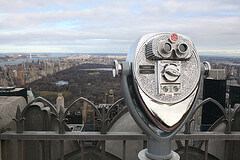Would you rather think differently than others or differently than you’re used to thinking? Chances are good that doing the second will get you the first.
Adapting our thinking to others’ patterns and processes is normal. We work together more smoothly. We agree more quickly. We experience comfort more often. And it may stultify.
Look to the habit of mental exercise outside the routine of crossword puzzles. The exercise changes thinking; the thinking stimulates employee engagement.
 Look closer. See more.
Look closer. See more.
When you notice something–a cloud, a broken pencil, a discarded Starbucks cup, a phrase–pause to notice more. Make the time to see it more clearly. Allow a moment to view from a different angle. Look for some aspect you’ve never considered, some comparison you’ve never had.
Be quick to metaphor.
Call out your imagination, your poet. Whether you observe something physical or think something abstract, reach for a comparison. That cup of pencils is a yard of silos. The sleek black stapler is an evil beaver. Let your mind work quickly. Don’t slow your thinking down by searching (or waiting) for the “right” metaphor.
Play with What-If
The What-If game generates new ideas by the dozens. The more often you play, the sooner you’ll say “by the scores” and then “by the hundreds.” What-If frees you from reality. What-If allows you to play with the craziest possible ideas. What-If can be played at either of 2 levels: fun and funner. Fun is simply imaging wacky situations: what if we wore shoes on our hands? what if we lived underwater? what if we were paid to stay at home?
Funner is inserting the “to do” between what and if. What would we discover if dolphins talked to us? What can we expand if the merger comes through? What will we change in our training if everyone works remotely?
And what if there are other ways to generate ideas? There are.
Make Changes.
Let’s go back to the visual. When you see something that draws your attention, change it. In your mind change its color. Change its shape. Change its texture. Change its size. You and your mind will play with those changes. How would I fry a 14 pound egg? If the sun were turquoise blue, would we still tan? That playing is really thought-changing.
Then think of how you do things. How can you do them differently? Changing what you see and changing how you do thing can be a step to being highly creative.
Look Fast to Think Faster.
Since change happens faster than ever before, why not rev up your thinking? Especially your thinking differently. This is simply the opposite of slow-motion. Practice looking at and really seeing as many things as you can, one right after the other. The more you do it, the better you’ll get. You’ll get better at seeing the details more quickly. You’ll get better at remembering more of what you see (and think) sequentially. You’ll get better at seeing not-necessarily-normal comparisons and links between different things.
OK, it’s a bit much to take on all 5 of these at once. Pick one; practice more than once; see if it feels comfortable and beneficial. Then move to another of the 5.
BONUS NOTE: These thought changers increase employee engagement. The changers above transfer to real application on the job. That’s employee engagement. Use these with your team. Introduce one at a time or send them the link to this blog post. Contact me if you have any questions or would like any tips.
(About the Author: As an Employee Engagement and Performance Improvement expert, Tim Wright, has worked with businesses and national associations of all sizes. His company, Wright Results, offers proven strategies and techniques to help businesses increase employee engagement, improve personnel performance and build a strong business culture by focusing on performance management from the C.O.R.E. For more information, visit www.wrightresults.com or connect with Tim here: tim@wrightresults.com)
To discuss World of Work topics like this with the TalentCulture community, join our online #TChat Events each Wednesday, from 6:30-8pm ET. Everyone is welcome at events, or join our ongoing Twitter and G+ conversation anytime. Learn more…
TalentCulture World of Work was created for HR professionals, leadership executives, and the global workforce. Our community delves into subjects like HR technology, leadership, employee engagement, and corporate culture everyday. To get more World of Work goodness, please sign up for our newsletter, listen to our #TChat Radio Channel or sign up for our RSS feed.
Do you have great content you want to share with us? Become a TalentCulture contributor!
Photo Credit: Brandon HM Oh via photopin cc
Post Views: 1,835